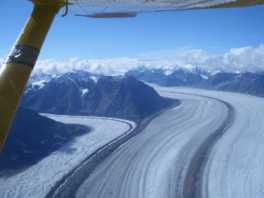Kaskawulsh Glacier facts for kids
Quick facts for kids Kaskawulsh Glacier |
|
|---|---|

Kaskawulsh Glacier junction from the air, August 2004
|
|
| Type | Valley glacier |
| Location | Canada |
| Coordinates | 60°48′N 138°36′W / 60.800°N 138.600°W |
| Length | 78 kilometers (48 mi) |
| Terminus | sealevel |
| Status | retreating |
The Kaskawulsh Glacier is a huge valley glacier found in the St. Elias Mountains. It is located inside Kluane National Park in the Yukon, Canada. A valley glacier is like a slow-moving river of ice that flows through a valley.
Where the Glacier Is Found
This amazing glacier sits high up, about 6,000–9,000 ft (1,800–2,700 m) above sea level. It covers a huge area, more than 15,000 sq mi (39,000 km2) of the land around it.
The Kaskawulsh Glacier ends at the start of two river valleys: the Slims River and the Kaskawulsh River. These rivers then flow into bigger river systems. The Kaskawulsh Glacier itself is formed when two smaller glaciers, called the Central and North Arms, join together. At its widest point, it is about 3–4 mi (4.8–6.4 km) across!
How the Water Flows
For a long time, until 2016, most of the melted water from the Kaskawulsh Glacier flowed into the Slims River. This river then went north to Kluane Lake and eventually reached the Bering Sea.
But in 2016, something big changed! As the glacier started to shrink, the water suddenly switched direction. Now, most of the meltwater flows into the Kaskawulsh River. This river goes east and then south to the Alsek River, finally reaching the Gulf of Alaska. Because of this change, the water level in Kluane Lake is dropping. Scientists think that soon, Kluane Lake might become a lake with no river flowing out of it.
Visiting the Glacier
If you like backpacking, you can visit the Kaskawulsh Glacier. A popular path is the Slims River West Trail. This trail follows the Slims River south for about 19.9 mi (32.0 km). It ends at the top of Observation Mountain, which is near the very end of the glacier. You can also take the Slims River East Route to reach the end of the glacier, also known as the glacier terminus.
Images for kids





